
XXXI Simpósio Brasileiro de Telecomunicações
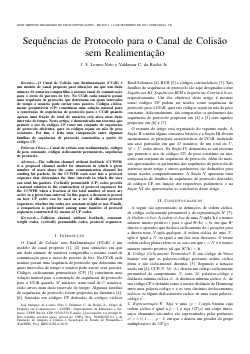
Sequências de Protocolo para o Canal de Colisão sem Realimentação
J. S. Lemos-Neto, Valdemar C. da Rocha Jr.
DOI: 10.14209/sbrt.2013.239
Keywords: Collision channel without feedback constantweight codes cyclically permutable codes protocol sequences
Abstract
The collision channel without feedback (CCWFB) is a proposed channel model for situations in which a given number of users share the same communication channel for sending bit packets. In the CCWFB each user has a protocol sequence that determines the time intervals in which the user can send his packets. Cyclically permutable (CP) codes provide a natural solution to the construction of protocol sequences for the CCWFB when a fraction of the total number of users are active in a given time interval. In this paper, a theorem is proved on how CP codes can be used as a set of efficient protocol sequences, whether the codes are constant-weight or not. Finally, a comparison is performed among some families of protocol sequences constructed by means of CP codesDownload
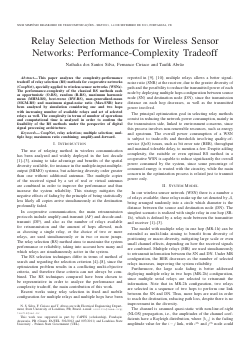
Relay Selection Methods for Wireless Sensor Networks: Performance-Complexity Tradeoff
Nathalia dos Santos Silva, Fernanco Ciriaco, Taufik Abrão
DOI: 10.14209/sbrt.2013.240
Keywords: CoopNet relay selection multiple selection multiple hop maximum ratio combining amplify-and-forward
Abstract
This paper analyzes the complexity-performance tradeoff of relay selection (RS) methods for cooperative networks (CoopNet), specially applied to wireless sensor networks (WSNs). The performance-complexity of the classical RS methods such as opportunistic (O-RS), random (R-RS), maximum harmonic mean (MHM-RS), best-worse (BW-RS), max-generalized-mean (MGM-RS) and maximum signal-noise ratio (Max-SNR) have been analyzed by simulation considering one and two hops with increasing number of available relays and set of selected relays as well. The complexity in terms of number of operations and computational time is analyzed in order to confirm the feasibility of the RS methods under the perspective of digital signal processing architecture.Download
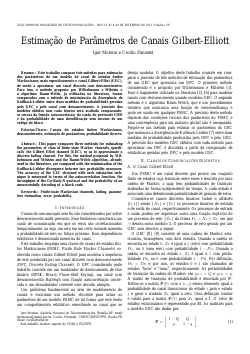
Estimação de Parâmetros de Canais de Gilbert-Elliott
Igor Moreira, Cecilio Pimentel
DOI: 10.14209/sbrt.2013.50
Keywords: Finite-state Markovian channels fading parameters estimation error probability
Abstract
This paper compares three methods for estimating the parameters of class of finite state Markov channels, specifically the Gilbert Elliot channel (GEC), so as to approximate a discrete fading channel. For this, the method proposed by Wilhelmsson and Milstein and the Baum-Welch algorithm, already used in the literature, are compared with the minimization of the Kullback-Leibler divergence between two probability measures. The accuracy of the GEC obtained with each estimation technique is measured in terms of the autocorrelation function, the throughput of the Go-Back-N protocol and the probability of an unsuccessfully decoding of a block code.Download
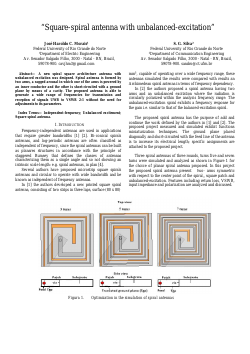
Square-spiral antenna with unbalanced-excitation
José Haroldo C. Morais, S. G. Silva
DOI: 10.14209/sbrt.2013.241
Keywords: Independent-frequency Unbalanced excitement Square spiral antenna
Abstract
A new spiral square architecture antenna with unbalanced excitation was designed. Spiral antenna is formed by two arms, a ragged arousal in which one of the arms is powered by an inner conductor and the other is short-circuited with a ground plane by means of a cavity. The proposed antenna is able to generate a wide range of frequencies for transmission and reception of signals UWB to VSWR 2:1 without the need for adjustments to its parametersDownload
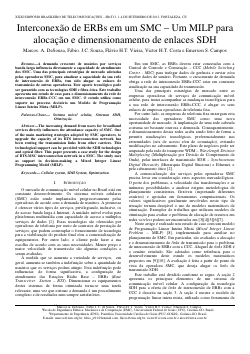
Interconexão de ERBs em um SMC – Um MILP para alocação e dimensionamento de enlaces SDH
Marcos. A. DeSousa, Fábio. J.C. Souza, Flávio H.T. Vieira, Victor H.T. Costa, Emerson S. Campos
DOI: 10.14209/sbrt.2013.52
Keywords: Cellular system SDH System Optimization
Abstract
The increasing demand from users for broadband services directly influences the attendance capacity of SMC. One of the main marketing strategies adopted by SMC operators, to upgrade the capacity of its BTS interconnection network has been renting the transmission links from other carriers. This technological support can be provided with the SDH technologies and optical fiber. This paper presents a case study for the design of BTS-MSC interconnection network in a SMC. The study uses as support in decision-making a Mixed Integer Linear Programming Model (MILP)Download
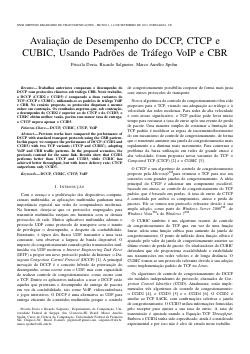
Avaliação de Desempenho do DCCP, CTCP e CUBIC, Usando Padrões de Tráfego VoIP e CBR
Priscila Doria, Ricardo Salgueiro, Marco Aurélio Spohn
DOI: 10.14209/sbrt.2013.242
Keywords: DCCP CUBIC CTCP VoIP
Abstract
Previous works have compared the performance of DCCP with standard transport protocols using the CBR pattern. In this paper, we compare the performance of DCCP (CCID2 and CCID3) with two TCP variants (CTCP and CUBIC), adopting VoIP and CBR traffic patterns. In the proposed scenarios, the protocols contend for the same link. Results show that CCID2 performs better than CTCP and CCID3, while CUBIC has achieved better throughput, but with lower delivery rate; CTCP outperform only CCID3Download
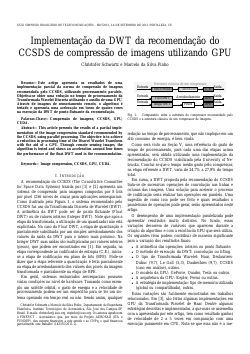
Implementação da DWT da recomendação do CCSDS de compressão de imagens utilizando GPU
Christofer Schwartz, Marcelo da Silva Pinho
DOI: 10.14209/sbrt.2013.57
Keywords: Image compression CCSDS GPU CUDA
Abstract
This article presents the results of a partial implementation of the image compression standard recommended by the CCSDS, using parallel processing. The objective is to achieve a reduction in processing time of the Discret Wavelet Transform with the aid of a GPU. Through remote sensing images, the algorithm is tested and shows an acceleration around four times the performance of the float DWT used in the recommendationDownload
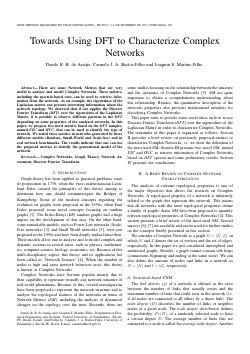
Towards Using DFT to Characterize Complex Networks
Danilo R. B. de Araújo, Carmelo J. A. Bastos-Filho, Joaquim F. Martins-Filho
DOI: 10.14209/sbrt.2013.60
Keywords: Complex Networks Graph Theory Network Assessment Discrete Fourier Transform.
Abstract
There are some Network Metrics that are very useful to analyze and model Complex Networks. These metrics, including the spectral-based ones, can be used to retrieve information from the network. As an example, the eigenvalues of the Laplacian matrix can present interesting information about the network topology. We observed that if one applies the Discrete Fourier Transform (DFT) over the eigenvalues of the Laplacian Matrix, it is possible to observe different patterns in the DFT depending on some properties of the analyzed networks. In this paper, we propose two novel metrics based on the DFT samples, named FZC and HVC, that can be used to identify the type of network. We tested these metrics in networks generated by three different models (Random, Small-World and Scale-free) and in real network benchmarks. The results indicate that one can use the proposed metrics to identify the generational model of the network.Download